Private Pier — Fishing License Required
The Stillwater Cove Pier sits, in my opinion, in one of the most beautiful settings of any California pier. The water is that of Carmel Bay, the shoreline is that of scenic Pebble Beach. It’s a beautiful small pier and the views from the pier are stunning!
Look slightly to the west and you’ll see the Pescadero Rocks, the rocky pinnacle and strands of kelp that give shelter to this cove and truly provide, on most days, water that seems almost motionless.

Look to your right and you’ll see Pescadero Point and the large pink structure known as the “Castle House,” perhaps the most famous—and expensive—house in Pebble Beach (and site of several movies).

Look to your left and you’ll glimpse Arrowhead Point and mystical Carmel; shift your attention just a little to the right and you’ll see Point Lobos, the beginnings of the Big Sur coastline, and the Santa Lucia Range. It’s a tapestry of shapes, colors and mood that taken together produce one of the world’s most beautiful scenes.


Turn around (do a whirling dervish) and look inshore and you’re confronted with an attractive beach, the exclusive Beach and Tennis Club, and one of the world’s more famous and beautiful golf courses—the Pebble Beach Golf Course. In fact, the 4th hole sits next to the shoreline by the pier and holes 5-7 effectively circle the cove. The 17th hole sits just the other side of the Beach and Tennis Club.
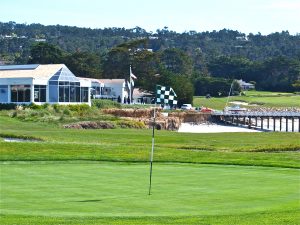

It’s kind of interesting—when the fishing is slow—to keep an eye on the golfers to see how they’re doing. And, you never know who might be on the links; it’s home to the rich and famous. One of the world’s great tapestry of scenes.



I’ve often thought that perhaps it’s just a tad too pretty a postcard setting to also be a good fishing pier and my results have tended to confirm that thought. On most days you’ll have the pier to yourself, at least as far as fishing. There is a boat hoist on the pier, and a limited number of divers are allowed to depart from the pier (10 a day), but I’ve never seen more than a couple of anglers on the pier. In fact, you’ll usually have the pier to yourself; about the only regulars are workers from the nearby club.


Environment. Although part of the Carmel Bay Ecological Reserve, sport fishing for fin fish is allowed as a sign at the front of the pier points out. The water here is shallow and, as mentioned, generally very calm due to Pescadero Point and the Pescadero Rocks, the outcropping of rocks that sit somewhat south of the Point and help protect the area from northwest swells.

Although fish-enticing rocks define much of the cove’s bottom, and line the shoreline area on one side of the cove, they’re just a little too far away from the pier to give it a rocky environment. Instead, the beach to the left of the pier and the bottom surrounding the pier itself is mostly sand that transitions into rock rubble as you get into deeper water. The pier pilings are concrete, with very little fish attracting growth on them, while heavy masses of seaweed and kelp are spread from the pier throughout the cove; giant kelp in the deeper waters, feather boa kelp in the shallows.
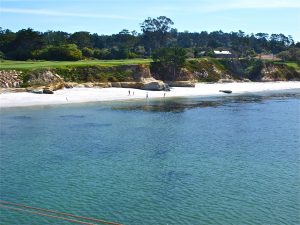
Due to the shallow-water, sandy-bottom environment around the pier, and a general lack of water movement, what looks so promising at first glance often leads to disappointment when measured strictly in terms of fish. Perhaps it’s better just to enjoy the setting and let the fishing be secondary in nature.
Somewhat surprisingly, two rocky-habitat species— blackperch and striped seaperch, seem to be the most common fish taken from the pier. In addition a few rockfish do show up, as well as a few cabezon and lingcod. Mostly though these hang around the nearby kelp and reefs rather than being residents of the pier area.
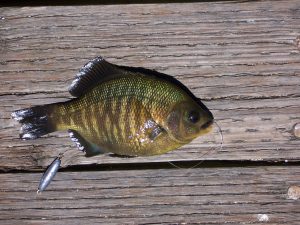
As for the sandy shore species, a few are taken—barred, calico, walleye, spotfin and silver surfperch, but their numbers seem limited. A few pileperch may also make an appearance and the state record pileperch, a large 2 lb. 8 oz. fish, was taken by a diver in the cove in 2011.
Common, at times, are jacksmelt and when a school heads by the rocks it can provide some steady action. In addition, the mix may also see a few more solitary species, flatfish, as well as a few leopard sharks and bat rays.
A non-fish species that does seem to be resident is harbor seals, I’ve rarely had a visit when at least a few of the pinnipeds weren‘t bobbing around in the water. Sea otters may also make an appearance and when they do they can be quite amusing—and distracting.
Make sure you enjoy the scenery because most days, as said, are not that great as far as fishing. Better fishing can be found from nearby shoreline areas, especially Arrowhead Point, but this is after all a pier fishing book.
Fishing Tips. Primary species are the aforementioned perch—black and striped—joined by lesser numbers of rubberlip and rainbow seaperch, all probably having wandered over from the nearby rocks.

They will be joined by barred surfperch, calico surfperch and walleye surfperch, species that prefer the sandy bottom around the pier. Joining them will be flatfish such as sand sole, starry flounder, sanddabs and perhaps a halibut (but you need the right bait or lures). A few leopard sharks are reported from the pier and a few rays.
Add in some small to medium-size rockfish (mostly grass rockfish), a stray cabezon or two, and an occasional lingcod, and you have a decent variety. Just don’t expect a lot of fish every day.

As for the perch, stick to the basics—pile worms, fresh mussels, ghost shrimp, or small pieces of market shrimp (all of which you will have to bring with you). For the barred surfperch you can try the sandy-shore area and try sand crabs (if you can find them), fresh mussels, pile worms or ghost shrimp. Like many areas, anglers are also beginning to use plastics—a variety of grubs and swim baits—for the perch.
The aforementioned baits will also attract the small to medium-size rockfish (that are often called rock bass by the locals). However, strips of squid can also be effective and may lure in a sole or shark. If seeking out the rockfish, cabezon, and lingcod, I suggest following the words of MB, a local who fishes the pier fairly often. His advice: “casting toward the 17th hole is where the rocky bottom and kelp bed begins to grow and where I catch all of my rockfish/cabezon from the pier (but you have to cast far and be prepared with heavy gear for snags). Even though there are pockets of kelp throughout, only perch seem to inhabit those areas.” As I always say, follow the advice of the locals. Do be prepared for some snags because you’ll probably get them. No pain no gain, right?

Some large leopard sharks and bat rays are also found in these waters so be sure to bring along a net. Problem here is keeping the bigger creatures from encircling bits of kelp with the line. As always, a bit of luck is needed if you hook a big fish. However, the pier is small and if necessary a fish can often be walked down to the sandy beach at the front of the pier or to the dock that is tethered to the end of the pier during the summer.
Again, don’t bring great expectations because they rarely will be filled. That is unless your expectations center on the ambiance of the spot, the sheer beauty, and its peaceful nature. All of those are great in contrast to rather drab fishing (on most days). As one local angler said, “It’s not a great pier since it doesn’t have deep water, but it’s almost automatic for perch and great for kids.”
Potpourri — Perhaps more than you want to know about the Stillwater Cove Pier
<*}}}}}}}}}>< — Sometimes I wish I were a diver! Although the top-of-the-water view here is beautiful, the underwater scene must be amazing. In an article by Bruce Watkins (Dive Spot Monterey County), he describes that undersea world: “The prominent feature of Stillwater Cove is the mass of rocks in the center of the cove. Known as Pescadero Rocks, most divers concentrate their activities around the rocks and in the reef directly south of the rocks… These rocks are covered with all of the colorful marine life that makes California diving so interesting—carpets of red corynactis anemones, giant green and blood red telia anemones, and yellow and cobalt sponges. Monkey-faced eels are abundant here but often go unnoticed. Their distorted faces are a bit grotesque but, nonetheless, interesting to photograph… Also, not a true eel, wolf eels inhabit Stillwater Cove. These strong-jawed fish feed on sea urchins and shellfish. Wolf eels are far less threatening than their name or appearance would suggest, are very shy, and rarely bother divers. As one gets nearer Pescadero Rocks the bottom juts up from 40 to 30 feet in a massive wall that runs nearly 100 yards. On the north side of the wall is a float marking the location of an underwater statue. At the base of the wall are a number of shallow caves, ledges and swim throughs. The walls are adorned with encrusting sponges in hues of cobalt red and yellow, and the nooks and crannies of the wall harbor an assortment of photogenic invertebrates… In the shallow water around Pescadero Rocks live an abundance of hermit and decorator crabs. This shallow area is also a great place to observe and photograph nudibranchs. The simple dorids, such as the lemon and Monterey nudibranch, are here in abundance. Just to test your photographic skill there are also more photogenic species. Photos of orange and white clown nudibranchs, gaudy red and white Phidianas and ostentatious Dendronotids will wow your friends.”
<*}}}}}}}}}>< — Stillwater Cove and the nearby Coast Guard Pier in Monterey are the only two sites in California where sea otters have been observed attacking and eating birds (it’s also been observed in Alaska). Species attacked included western grebes, cormorants, surf scooters, common loons, and gulls. Otters have been observed approaching birds from under the water as the birds rested on the surface, then dragging the birds underwater while wrestling with them and biting them. Attacks lasted up to fifteen minutes before the bird was eaten. At the same time female otters have been observed carrying around a bird carcass on their chest for an hour or more. Scientists aren’t quite sure what to make of the phenomenon.
<*}}}}}}}}}>< — Although the cove and setting have a rather “pristine” feel to them, looks can be deceiving. Heal the Bay, a Santa Monica-based group that monitors water quality at 370 locations along the coast, rated Stillwater Cove as one of the three dirtiest beaches (“Beach Bummers”) in Northern California along with Campbell Cove State Beach in Sonoma County and Pillar Point Harbor in Half Moon Bay. At least that was the finding in 2005.
“For the fourth year in a row, Stillwater Cove at the Beach and Tennis Club scored markedly worse than all other monitored Monterey County beaches by receiving an F grade. Stillwater Cove, as its name implies, has poor circulation and little tidal flushing. In addition, this location tends to be a favorite of marine mammals and birds. The only other known source in the area is a constantly running storm drain, which mostly services the local golf course.”
—Heal the Bay, 2004-2005, 15th Annual Report
The good news is that Stillwater Cove received “A’s” on the 2008 and 2009 report cards given by Heal the Bay so evidently things are improving.
<*}}}}}}}}}>< — Like many of California’s piers and their beaches, this cove and pier was used in a movie—Captain January (1936).
<*}}}}}}}}}>< —
Rescuers struggle to save amazing giant squid

WHILE NOT quite of the gargantuan proportions of Jules Verne’s famous giant squid, a group of Humboldt squid that washed ashore at Stillwater Cove in Pebble Beach last week were certainly mysterious and fascinating — and huge.
When Joey Guilatco arrived for work at the Beach and Tennis Club at 5 Friday morning, he was told that a club member walking her dog had found several squid stranded on the nearby beach.
With a flashlight, Guilatco went down to the beach and searched in the early morning darkness. And while almost everyone else was still peacefully dreaming in bed, he came across a sight that did not seem to belong to the waking world — more than a dozen of the largest squid he’d ever seen, many still alive, scattered along the beach.
They were “moving, breathing, and spewing some kind of saliva,” Guilatco said.
It was their size that struck him most. Including their tentacles, some were five feet long. They weighed about 10 pounds each, which Guilatco learned as he and other P.B. employees tried to lug the living animals back to the ocean.
He called the Moss Landing Marine Laboratory to report the incident and see if the experts could explain the bizarre event. They instructed Guilatco to preserve the dead ones in ice while they considered sending a scientist to investigate.
Guilatco and the other employees collected the squid and put them on a bed of ice on a picnic table at the beach.
Souvenirs? The Moss Landing people never came, but the squid did not go to waste. By the end of the day, all but one had been taken.
—Regan Carey, The Carmel Pine Cone, October 16, 2003
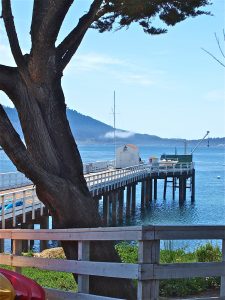
History Note. It’s a little hard to imagine today but the cove and its shoreline once served as home for a Chinese fishing village. The Chinese had fished Carmel Bay since 1851 when they set up a camp in Point Lobos; soon after two additional camps were established, one at Pescadero (today’s Stillwater Cove), and one at Point Alones (near Cannery Row). By 1853 a settlement was recorded at Cabrillo Point (China Point), the site of today’s Hopkins Marine Station. It would be the main Chinese settlement for many years.
The Chinese were skillful fisherman and a large part of the Monterey fishing industry for many years but eventually they came into conflict with other immigrant groups, especially the Italian-American fishermen. Increasingly restrictive laws made it hard to fish and process their catch, and when combined with a mysterious fire at the China Point settlement in 1906, the decline of the “Chinese fishing villages” almost seemed inevitable. The Pescadero camp itself apparently came to an end in 1912.
In 1916 the Monterey Cypress newspaper reported plans for a pier and bathhouse at the cove. Just a few years later, in 1919, the small fishing lodge had grown to be “one of the finest fishing clubs in the country.” That lodge was the forerunner for today’s Beach & Tennis Club building that sits near the front of the pier.
The Seventeen Mile Drive curves through the spacious homes and gardens of Pebble Beach… at 14 m. is the junction with a paved road.; R. 03m. to Stillwater Cove with its arch rock, its fishing club and bathing beach, yacht harbor and marine gardens (glass-bottom boats, 50 cents).
—California, A Guide To the Golden State, Federal Writers Project, Works Progress Administration, 1939
By 1948 the original pier was beginning to show its age and a new pier was needed. The new pier would be built by the Stillwater Yacht Club, a deed commemorated by a small sign near the entrance to the pier: “Matthew & Mimi Jenkins Pier. First Commodore & First Lady. Stillwater Yacht Club. Est. 1948.”
Not mentioned is the fact that Matthew Jenkins was also one of the developers of Pebble Beach and that the Jenkin’s had bought the 5.5 acre parcel overlooking Stillwater Cove in 1943 for $43,000. Their purchase, and refusal to sell it to Samuel Morse who developed Pebble Beach Golf Links, prevented his plan for a shoreline hole No. 5. The building of the shoreline hole would not take place until 1999 when the heirs to Mimi Jenkins sold her property.
As happens to all coastal piers, the sea and weather take a toll. Sooner or later wood (especially the pilings) deteriorates and repair or a rebuild is necessary. In this case, the pier was condemned in 1980. Another new pier was needed but the story of the new pier would take several interesting twists before completion.
In 1977 the Del Monte Properties Company had reincorporated as Pebble Beach Corporation and then, in 1979, the company was bought by Marvin Davis who owned Twentieth Century Fox. It was during his tenure as owner that The Inn & Links at Spanish Bay was developed (in part, as rumor has it, to increase cash flow).
Davis needed the approval of the Coastal Commission to build the new resort and they were agreeable with a number of conditions, one being that “Public Access” be gained for Stillwater Cove.
However, the property at the cove was owned by Mimi Jenkins (following the death of Matthew her husband). As matriarch of her family, and still involved with the yacht club, she was agreeable to the public access with several additional conditions that she had her attorney add to the mix. The Pebble Beach Corporation company would build a new pier and put a hoist on the pier. In addition, they would have a Harbor Master on duty part of the year (May 15-September 15). 50 visitors would be allowed to visit the cove (and pier) per day but no more than 10 divers a day and they would no longer be allowed to shoot fish under water, only observe and/or photograph them. The cove and pier would remain open to all residents of Pebble Beach.
The corporation and the coastal commission agreed to the conditions and a new pier was constructed (for a relatively modest $500,000).
The Pebble Beach Corporation would go through further change and ownership, but the pier with its special conditions has remained relatively unchanged since 1984 (although a new hoist is planned for the pier).
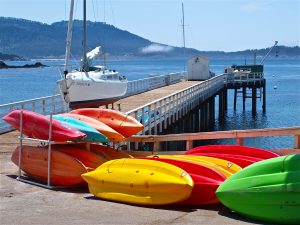
Stillwater Cove Pier Facts
Hours: Open daylight hours. Access is through the parking lot of the Beach & Tennis Club
Facilities: Few, since this pier was not designed as a fishing pier. There is a limited amount of coastal access parking near the entrance to the club‘s parking lot. Look for the tall hedge and you’ll see (ten spaces) that are gone quickly given the number of divers who visit the area. Always call 831-625-8536 to reserve a space if you intend to visit. Restrooms are found near the front of the pier.
Handicapped Facilities: Handicapped parking (one space) but non-handicapped restrooms. The pier surface is wood planking with a rail height of 43 inches; an 8-inch curb runs along the entire length of the pier making access to the railing difficult. Not posted for handicapped.
How To Get There: From Highway 1 take the Pebble Beach Exit. As soon as you exit you will see a toll station and the entrance to the famous 17-Mile Drive. Pay roughly $10 (it keeps going up) to traverse these hollowed grounds and follow the drive about three miles to the Beach & Tennis Club turnoff. Turn left onto Palmero Way; .24 miles turn left onto Cypress Drive, look for tall cypress tress and a narrow parking lot that is reserved for public access—just up the street from the club.

great read.